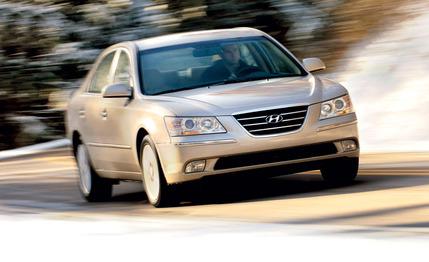
 Short Take Road Test
Short Take Road Test
For 2009, Hyundai took its satisfying Sonata mid-size sedan—already a more-than-credible alternative to the segment’s entrenched big dogs—and endowed it with more power and refreshed styling inside and out. As enthusiasts, however, we were most interested in what the company had done to improve the “sporty” SE trim—namely, whether or not it’s actually sporty.
It’s No Hyundai Quattroporte, but It’s Better Than Before
The SE is obviously no sports car, but it does now boast a bit more enthusiasm in its footwork. Previously more of an appearance package than anything else, the 2009 SE rides on all-season rubber (Kumho Solus KH16 tires) but gets a unique state of tune for the control-arm front and multilink rear suspension.
Other than the suspension upgrade, the $1600 increase for the SE model includes 17-inch aluminum wheels, a power driver’s seat, steering-wheel audio controls, and a telescoping steering wheel.
The body control is good, and the damping even more so; the SE’s firmer suspension and thicker anti-roll bars fix a lot of the complaints we had about the floppy feel of our long-term Sonata LX. The SE corners confidently, with its 0.78-g skidpad performance just 0.03 g behind that of the Nissan Altima 3.5SE, a familiar benchmark for sporty family sedans. Braking is just a tad behind the segment leaders, with 70 to 0 mph taking 177 feet in the Sonata versus 173 in the Altima 3.5 and 170 in a V-6 Toyota Camry.
The steering is accurate but disappointing in that it’s pretty lifeless on center and doesn’t get any better as you move the wheel. You might be tempted to conclude that feel is a sacrifice to the front-drive understeer gods—and the Sonata understeers a lot—but the Honda Accord manages to communicate what’s happening at the front wheels.
The 249-horse—up from 234—V-6 sounds great, and with 229 pound-feet of torque, it provides plenty of usable grunt. The five-speed automatic is above average, too, but both automatic and manumatic modes are too slow-witted for spirited driving; we got a bit frustrated waiting for the called gear to show up. Shifts, once the box decides to initiate them, are smooth.
Furthermore, manumatic mode no longer holds ratios and shifts far before redline, though, which likely accounts for the new car’s 6.9-second 0-to-60-mph time—0.3 second slower than the time we got from a 234-hp 2006 model. Four-cylinder SE buyers can opt to row their own gears, with a five-speed manual as standard.